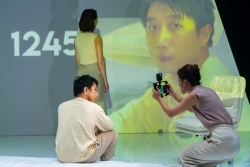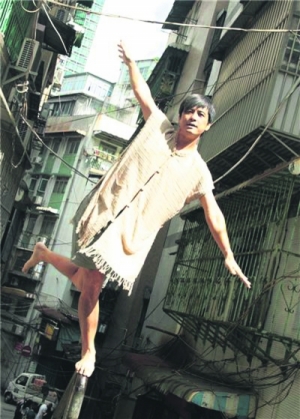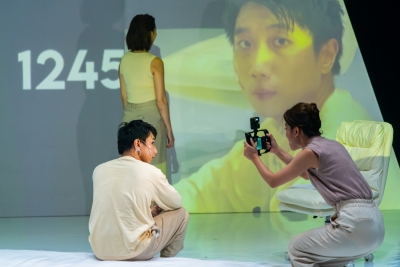 |
Anamnesis no.: XXXX ("Anamnesis"), an adaptation of Peter Shaffer's Equus, is produced by the Dirks Theatre Association for the 34th Macao Arts Festival under the local artist category. The lead creator Ip Ka Man, the director and adaptor of Anamnesis, boldly attempts to make the story relevant to the current audience by incorporating real-time imaging technology to address the current topic of social media short videos ("Shorts"). The concept appears attractive and full of potential on paper, especially when the adaptation is based on an acclaimed dramatic play - Equus. However, despite some moments of inventiveness, the production emerges as a fragmented piece in which the narratives and art forms compete against each other, resulting in the audience feeling confused and unsatisfied.
This article examines how Anamnesis approaches contemporary adaptation in terms of its form and content.
Anamnesis follows the same plot as Equus. Equus. is a story about a psychiatrist, Martin Dysart, diagnosing a young patient, Alan Turning, who has committed the bizarre crime of blinding six horses with a metal spike in a stable. As Dysart uncovers Turning's passionate obsession with horses, he begins to question whether his professional practice is actually helping his patients. The conflict of Equus deals with the topic of societal conformity suppressing individual desire. Anamnesis follows the Equus story without altering the sequence, but its telling is fragmented and obscure.
The fuzziness of Anamnesis's narratives can be accounted for by Ip's creative decision to make significant reductions in his adaptation of Equus. Anamnesis is performed by five performers and lasts for slightly over an hour, while the original 1973 Equus production involved fifteen performers and was two and a half hours long. Patently, the dialogues between Dysart and Hesther Salomon, a magistrate, and between Dysart and Turning, are retained and stripped down in Anamnesis. Crucial information, such as Turning's family background, is fed directly to the audience in quick succession to drive the plot forward. For instance, in Equus, Dysart tried to obtain pieces of information related to Turing from his parents on multiple occasions. In comparison, Turning's parents in Anamnesis offer those pieces of key information in the form of a monologue without any resistance. Therefore, these pieces of information have not left a deep impression on the audience as they are not earned from Dysart's action of probing. This causes Anamensis to resemble a narrative more than a drama. Furthermore, all three three central characters, Dyart, Turning and Salomon are static and demonstrate no epiphany and character growth. As such, the flat narrative mirrors a hollow scenario reconstruction in news programmes, leaving the audience contemplating its relevance to them.
Ip tries to centre his adaptation on Shorts to connect the aged play to the present audience. Anamnesis adopts a play within a play structure. The outer narrative is a group of video content creators ("Unnamed Narrators"), shooting the story of Equus; the inner narrative is a watered-down story of Equus. In some scenes of the outer narrative, the Unnamed Narrators have intellectual debates on the video content creator's ethics, such as whether they should be in service for view counts or the truth. Unfortunately, the outer narrative being brief in length inhibits an in-depth discussion and leaves multiple crucial questions unanswered. Those questions revolve around the identity of those Unnamed Narrators and their motivation to retell the Equus story.
The author is indifferent towards the creative choice focusing on Shorts in Anamnesis. In the meet-the-artist session, Ip revealed that Shorts served as a contemporary substitute to television in Equus because the general population tended to watch video contents through their phones rather than via television in present time. First of all, the author opines that there is no need for contextualising the element of television because it is still understood by today's audience. Furthermore, television is not a key motif in Equus which the play cannot function when left out. Secondly, the nature of the substitute is at odds with the original element. Television carries the connotation of societal conformity because television content is broadcast to a mass audience and is usually deemed appropriate and socially accepted. Sometimes, television is even perceived as a tool to strengthen social conformity. In contrast, Shorts is connected to the ideas of individualism and unconventional since their creators are independent and their contents defy the conventions of mass media. Thirdly, from a dramaturgical perspective, if Ip focuses on examining Shorts in Anamnesis, the Equus story should be replaced by any strange or controversial incident because Equus is already a complex and dense story. By weaving two incongruous narratives in a short period, Anamnesis comes across as too condensed. Neither of the narratives is given enough time to be told clearly to the audience. To adapt Equus centring around Shorts is still feasible, but it will require much more conceptualisation and a longer performance time which the current production cannot afford.
Stage Photo
(provided by Macau Arts Festival)
In terms of form, Anamnesis is a production that incorporates commonly available real-time imaging technology and a simple set. Naturally, the specifically described set, detailed stage direction, masks and physical actions stated in the published Equus play script are all discarded to make room for the new vision. The set of Anamnesis materialises as a modern small studio that comprises three large horizontal screens positioned on the floor, at the upstage position facing the audience and on the ceiling. At times when there is no projection, the white screens also hint at the iconic white walls of mental hospital wards often portrayed in films. Throughout the performance, the performers, playing the role of actor/actress and the role of Unnamed Narrator, recreate the scenes in Equus with the use of a table, a couple of chairs, a bed and some simple props. The real-time moving images, sometimes raw and often manipulated with digital filters and effects, were projected on the aforementioned screens mentioned.
Indeed, the real-time imaging technology in Anamnesis fits into Ip's vision of using Equus story to explore the nature of Shorts. The actual happening on stage and the processed video feeds are presented to the audience simultaneously enabling them to identify how the captured images are being manipulated and the intention behind such manipulations. The audience is as if participating in a perpetual attention game. Not only are they required to keep track of the events occurring on stage, but also they are expected to understand the meaning of the processed images, and at the same time they need to figure out the mechanism of the image creation and manipulation. All these elements are constantly engaging the audience, creating an overwhelming and slightly exhausting viewing experience. The experience reminds the author of a similar experience of scrolling through Shorts. The viewer is immersed in the viewing experience of Shorts, but the viewer can hardly recollect the content in minute detail that has been watched. Ip successfully recreates the viewing experience of shorts on stage through real-time imaging technology.
Some good applications of real-time imaging in Anamnesis are particularly memorable. One of the fantastic applications is to display the faith of the characters on the screen via a blurry symbolic image. For instance, a drawing of a black horse head is utilized to underline Turning's obsession with horses, a gradually increasing view count is employed to demonstrate the Unnamed Narrator's conviction that popularity is king; a cross necklace is projected to show Turning's mother's belief in God; and the waving hands of himself to depict Turning's father is infatuated with control. These symbolic images highlight the characters' core beliefs without being too distracting to the audience. The other terrific application is to depict Turning's peculiar mindset. A close-up shot of a young actress's hair and dress captures the seductive attraction felt by Turning when he brushes a horse in a stable for the first time. Conversely, Turning's apathy to Jill Manson's intimacy is alluded to by neutral images, such as a girl's belly button is projected when Turning looks at Jill's breast, and plugging in two electrical adapters together is presented when Turning lies about having sexual intercourse with Jill. The neutral images though not repulsive, are cold and unpassionate and are not the adolescents' conventional association to sex. This interesting contrast of images allows the audience to peek into the events from Turning's perspective. These two applications of real-time images have done brilliantly to supplement the story by introducing another perspective subtly.
Stage Photo
(provided by Macau Arts Festival)
As a whole, Anamnesis refuses to settle in a specific art form. It is a performing art and at the same time, it can fall under the video art form. The performers try to strike a balance between stage performance and real-time imaging. Unfortunately, in some instances, the balance is tipped towards video art form when an enormous effort is placed into real-time image capturing. For example, in the scenes in which Dysart is arguing with Salomon, the characters in focus are almost stationary on stage while the Unnamed Narrators who are shooting with cameras are constantly traversing across the stage. These huge movements unnecessarily grab the audience's attention. The scenes become video-driven because it conveys to the audience that the real time image is more important than action on stage. Besides, performers restrained by the cameras are unable to express freely with movements on stage. This makes the author think whether the use of video is hindering the direction of the scenes on stage.
To sum up, Anamnesis is a courageous adaptation attempt to fuse the Equus story with real-time imaging technology. If there is a sharper focus on its form and content, the production has the potential to become an inspiring contemporary piece that comments on social media short videos.
本網站內一切內容之版權均屬國際演藝評論家協會(香港分會)及原作者所有,未經本會及/或原作者書面同意,不得轉載。











